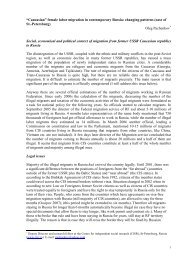THORIUM AS AN ENERGY SOURCE - Opportunities for Norway ...
THORIUM AS AN ENERGY SOURCE - Opportunities for Norway ...
THORIUM AS AN ENERGY SOURCE - Opportunities for Norway ...
You also want an ePaper? Increase the reach of your titles
YUMPU automatically turns print PDFs into web optimized ePapers that Google loves.
The Front End of the Thorium Fuel Cycle<br />
Based in part on R&D pioneered by ORNL and other laboratories, private companies, especially<br />
Du Pont at Savannah River and Battelle Pacific Northwest National Laboratory at Han<strong>for</strong>d,<br />
Babcock and Wilcox, and others, under USAEC contracts, have installed pilot-to-industrial size<br />
facilities to produce the different types of fuel used in the prototype reactors, BWR, PWR and<br />
HTR. Fuel-based products could be obtained from National Lead, Mallinckrodt, Nuclear Fuels<br />
Services, among others.<br />
Complete fuel element fabrication on the 10 kg scale was available at Babcock and Wilcox [36],<br />
and Allis-Chalmers had built a remotized fuel refabrication pilot facility at Rotondella, Italy, <strong>for</strong><br />
Elk-River BWR fuel [37].<br />
The KILOROD Fuel Fabrication at Oak Ridge National Laboratory (ORNL) was operated in the<br />
1960s on a 10 kg/day scale. The process scheme was based on the sol-gel process and vibratory<br />
compaction of the powders into the pin cladding. 1280 kg of thoria were processed in an 8 months<br />
campaign. The average radiation exposures in the KILOROD program were 0.19 mSv (milli<br />
Sievert 2 ) per man per week <strong>for</strong> the sol-gel process and the rod fabrication. Considering the<br />
accepted practical dose rates at the time (1968), which were of 20 - 50 mSv per year per operator,<br />
it was concluded that direct fabrication is feasible with (Th,3%U-233)O2 fuels that contain less<br />
than 20 ppm U-232. With shadow shielding, this limit can be increased to 200 ppm. With shadow<br />
shielding and frequent cleaning and recycling, the limit is 600 ppm. Plants with larger capacities<br />
will require shielding when operating permanently.<br />
Similar results were obtained at a pilot fabrication plant of about 10 kg HM/batch operated from<br />
1965 at Babcock and Wilcox on the same ORNL process. Its cost was 1 million dollars in 1965. It<br />
consisted of a sol-gel preparation plant and a fuel fabrication plant. Both plants, like KILOROD,<br />
were partly shielded only. In 1968, the total production at the plant was about 1150 kg. Up to<br />
1968, 119 rods (232 kg of (Th,3%U-233)O2) were fabricated. The U-233 contained 42 ppm U-232.<br />
The TURF ORNL Remote Fuel Fabrication Prototype Plant: As early as 1965, it was realised that<br />
industrial-scale fabrication plants would have to be totally remotized. ORNL engineers designed<br />
and built the TURF (Thorium-Uranium Recycle Facility) plant with remotely operated, manually<br />
maintained equipment having production capacities from 60 to 3700 kg/day of heavy metal. The<br />
TURF facility was intended to fabricate oxide (Th,U-233)O2 fuel <strong>for</strong> water-cooled reactors and<br />
carbide fuel <strong>for</strong> HTGRs. The personnel radiation exposure is limited to 0.4 mSv/week. A shielding<br />
of 10 cm steel was chosen as a practical limit <strong>for</strong> semi-remote fabrication, because of the difficulty<br />
of working through a greater distance with gloved hands. A cost analysis based on these designs<br />
showed that remote fabrication of oxide and carbide fuels would cost almost 1.5 to 2 times more,<br />
respectively. The assumptions taken at the time do not now seem conservative, and heavier<br />
shielding would be necessary (~ 1.2 m) and hence possibly a higher cost.<br />
Although such a plant could be built and operated, the fuel fabrication step has been the main<br />
roadblock to the development of the thorium fuel cycle to date. These technical complexities,<br />
especially penalizing 30 years ago, and the added costs, combined with other factors, have led to a<br />
provisory abandonment of this fuel cycle (except in India <strong>for</strong> strategic reasons).<br />
The enormous technical progress accomplished since the 1960s, in mechanics, electrical motors,<br />
materials, electronics and computers, and practical examples of remotized fuel fabrication<br />
(MELOX in France) suggests that these fuel fabrication concepts be revisited so that their<br />
advantages can be realised in the not-too-distant future.<br />
2 The Effect of the Absorbed Dose: Equivalent or Effective Dose = Sievert (Sv)<br />
35

















